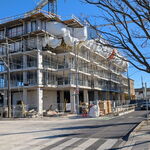http://www.boston.com:80/ae/theater...ns_heroic_concrete_buildings/?s_campaign=8315
Architecture
The beauty of concrete
Young architects say there’s much to love about city’s ‘heroic’ buildings
By Robert Campbell
Globe Correspondent / January 3, 2010
Big, gray, aggressive, muscular buildings, like Boston City Hall?
Wrong.
A bunch of young architects in Boston are singing the praises of a whole generation of Boston buildings made of concrete. They call it the “heroic’’ period of Boston architecture. It lasted maybe 20 years, from the late 1950s to the middle 1970s.
About one thing, they’re absolutely right. Love it or hate it, there really was a Boston Age of Concrete. It’s time we began to accept it as one of the historic periods of local architecture, just like Colonial or Victorian.
These architects, Mark Pasnik, Chris Grimley, and Michael Kubo are in their late 30s. All are associated with a design firm that calls itself “over,under,’’ which also runs a gallery in the same South End location called pinkcomma. Last fall, they curated an exhibit of concrete architecture at pinkcomma called simply “Heroic,’’ which they hope, eventually, to turn into a book. In doing so, they’ve raised an issue that deserves some thought by anyone interested in Boston area architecture.
They identified 154 buildings, in Boston and Cambridge alone, that qualify for inclusion in “Heroic.’’ Today the Age of Concrete is timely again for the simple reason that many of its monuments are in danger of being demolished. That’s most notably true of City Hall, the crown jewel of the era, which Mayor Menino hopes to get rid of.
A single statistic demonstrates how strong was the taste for concrete in that time, at least among architects. The Boston Society of Architects gives an annual award, the Parker Medal, for the “most beautiful’’ new building of the year. Between 1964 and 1976, 11 of the 12 Parkers went to buildings made almost entirely of concrete. Only the pink granite tower at 28 State St., in 1971, broke the string.
A list of the remarkable buildings of the heroic period would include the Carpenter Center at Harvard, by famed French architect Le Corbusier; the Christian Science Center, by I.M. Pei and Araldo Cossutta; Boston City Hall, by Kallmann, McKinnell and Knowles; the Design Research store in Cambridge by Benjamin Thompson; the State Services complex on Cambridge Street by Paul Rudolph; a series of buildings at Harvard by Josep Lluis Sert, including the Holyoke Center; and a series at MIT by Pei, including the Green Earth Sciences tower.
No other American city boasts as much noteworthy concrete architecture in as small an area as Boston and Cambridge.
Why did architects suddenly fall in love with concrete? Michael McKinnell, one of the architects of City Hall, was interviewed for the “Heroic’’ show. He gives a fascinating explanation of why he made the building almost entirely of concrete, both inside and out. He compares concrete buildings to what he calls “cosmetic architecture,’’ by which he means buildings with invisible steel frames that are given a fancy skin of some other material, often stone or brick.
Says McKinnell: “We were particularly interested in imbuing architecture with authenticity. . . . When you build in concrete, what you see is what you get. . . . The characteristic of concrete we enjoyed most was that one material could do so much. . . . I think if we could have done it, we would have used concrete to make the light switches.’’
Like rock fans, architects sometimes admire work that avoids conventional beauty. McKinnell remembers a comment by famed architect Philip Johnson, who said about City Hall: “Absolutely marvelous. I think it’s wonderful. And it’s so ugly!’’
“We thought that was the greatest praise we could get,’’ says McKinnell.
For its fans, concrete has many good qualities. It can be molded into any shape. It can symbolize permanence, as it does in Roman monuments like the Pantheon. It weathers over time, with stains and erosions that map its age like the skin of a person. In Boston in the 1960s, it symbolized a deliberate break with the past, a march into a new world and a reinvented city - “the New Boston,’’ as it soon came to be called.
For its foes, though, concrete is simply appalling. Partly, I think, that’s because we tend to associate it with unaesthetic constructions like highway ramps and tunnels.
The heroic age here ended abruptly. The oil embargo of 1975 made concrete construction more expensive. Steel was cheaper and faster. And the tide of taste changed. In the Bicentennial year of 1976, the Quincy Market opened, a restoration of an 1826 building. Boston was turning away from the future and engaging with its past. Of the 30 Parker Medals awarded since 1976 only four, by my count, have gone to buildings made primarily of concrete.
Human beings who pose as heroes can be pompous and bullying. So can “heroic’’ buildings. It’s foolish to save them all. I don’t think anyone is going to miss, let’s say, the Government Center Parking Garage when it disappears.
But architecture, like other arts, has a funny way of coming back into fashion after a period of neglect. The over,under architects may be a harbinger. There have been other signs of a renewed interest in modernism.
One is the great exhibition now at the Museum of Modern Art on the Bauhaus, the 1920s school in Germany that helped create the modern movement. Another is the fact that students and other young people seem typically to decorate with modernist stuff like that of IKEA, because modern furnishing goes well with information technology. Another straw in the wind, locally, was the recent celebration at the old Design Research store on Brattle Street, which is now once again filled (even though you can’t buy it) with the Scandinavian modern of its 1960s heyday.
The Age of Concrete was a brief chapter, but a fascinating one, in the history of Boston architecture. We don’t have to sanctify it, but we shouldn’t rip it all down either. The task today is to recognize that the era existed and that it mattered, and to begin the task of evaluating what was good and what was bad.





